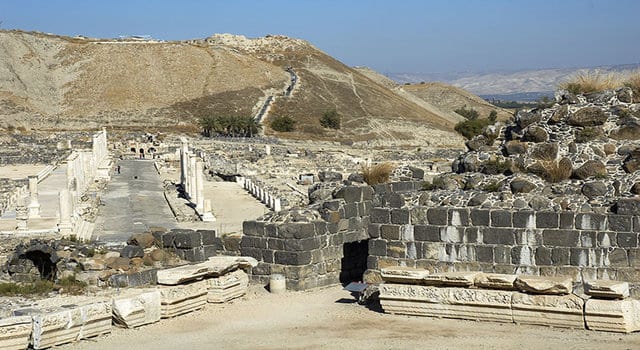
The ruins of the biblical city Samaria, capital of the Northern Kingdom of Israel during the 9th and 8th centuries BCE, lay unprotected and largely abandoned today, just outside modern-day Nablus. Changing security concerns led Israeli authorities to cease its excavation and research efforts after the Palestinian uprising which began in 2000. It had been conducting conservation and development efforts at the site, known today as Sebastia, in the 1990s.
Biblically, the area is first mentioned in 1Kings (16:23-24):
כג בִּשְׁנַת שְׁלֹשִׁים וְאַחַת שָׁנָה, לְאָסָא מֶלֶךְ יְהוּדָה, מָלַךְ עָמְרִי עַל-יִשְׂרָאֵל, שְׁתֵּים עֶשְׂרֵה שָׁנָה; בְּתִרְצָה, מָלַךְ שֵׁשׁ-שָׁנִים.
23 In the thirty and first year of Asa king of Judah began Omri to reign over Israel, and reigned twelve years; six years reigned he in Tirzah.
כד וַיִּקֶן אֶת-הָהָר שֹׁמְרוֹן, מֵאֶת שֶׁמֶר–בְּכִכְּרַיִם כָּסֶף; וַיִּבֶן, אֶת-הָהָר, וַיִּקְרָא אֶת-שֵׁם הָעִיר אֲשֶׁר בָּנָה, עַל שֶׁם-שֶׁמֶר אֲדֹנֵי הָהָר שֹׁמְרוֹן.
24 And he bought the hill Samaria of Shemer for two talents of silver; and he built on the hill, and called the name of the city which he built, after the name of Shemer, the owner of the hill, Samaria.
Traditionally considered the burial place of John the Baptist, therefore holy to both Christians and Muslims, Sebastia is located at a major historical crossroads. “You can learn the history of the whole region (by) staying here because all the powers that crossed the region since the time of the Egyptians were passing through,” said Carla Benelli, an art historian who has been working on restoration projects in parts of the site, financed in part by the Italian government. “From this point of view, it’s really very important.”
Covering the area of roughly a square kilometre, and stretching from the modern Palestinian village of Sebastia to the nearby hilltop once home to Samaria, the excavation site includes a Crusader cathedral, an ancient Roman city boasting a forum, a colonnaded street and a temple to Augustus, and the remains of the palace of Omri, the 9th century ruler of the Kingdom of Israel. Because of the lack of supervision in the area, it has been targeted by looters conducting illegal excavations and making off with precious artefacts, such as statues, vases, coins and glasses.
The complication lies in the administrative division; most of the area is under the jurisdiction of the Israeli Civil Administration, but some of it is under Palestinian control. Despite claims by the Civil Administration that it is trying to coordinate preservation efforts with the Palestinians, nothing has been accomplished.




